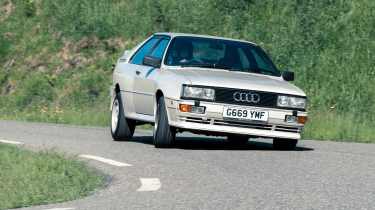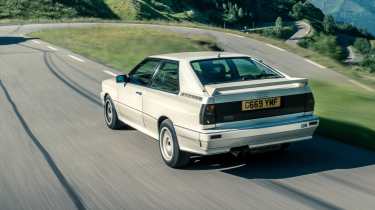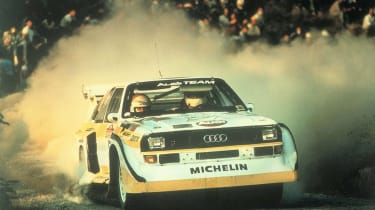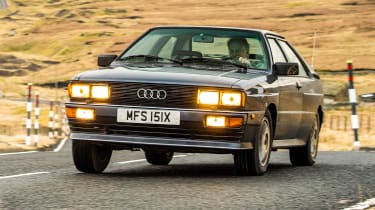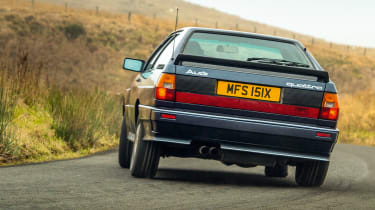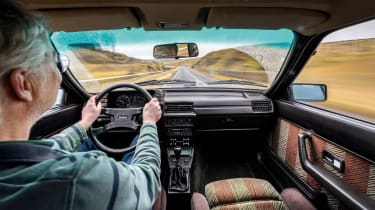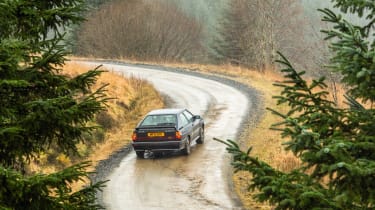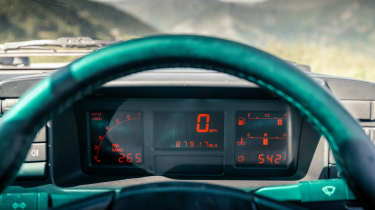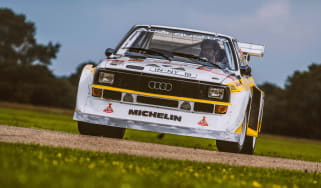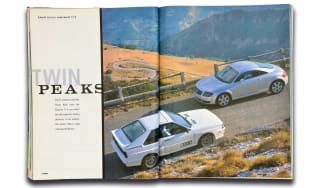Audi Quattro (1980 - 1991) review: a 1980s road-going rally icon
Arguably Audi's definitive model, the Quattro is an inimitable moment in motoring history that's all Ingolstadt's own
The importance of the Audi Quattro should not be underestimated. Not only is it the car that established Audi’s reputation for creating fast, secure, desirable, well-built cars, but in one fell swoop it revolutionised rallying with its four-wheel-drive system while normalising all-wheel drive in road-going performance cars.
The original Audi Quattro is now often called the Ur-Quattro to help differentiate this boxy coupe from Audi’s four-wheel-drive system (quattro with a small ‘q’) and later four-wheel drive models. The ‘Ur’ is a German prefix meaning earliest or original.
> BMW M3 (E30, 1986-1990) review – the greatest M car of all?
Given that today Audi is synonymous with four-wheel drive, it seems odd that back in 1976, when Ingolstadt engineers first started thinking about an all-wheel-drive performance road car, the idea was met with resistance. Before the Audi Quattro, four-wheel-drive cars were mostly robust, industrial off-roaders or heavy and clunky road cars. Most of them, even the all-wheel-drive Jensen Interceptor FF, used a bulky and old-fashioned transfer box to split torque between the axles, a concept that didn’t fit with Audi’s philosophy for making sophisticated, high-tech cars.
Audi Quattro history
To get the Quattro project started, Audi engineers created a mule from a two-door Audi 80, fitting it with the drivetrain from a VW Iltis, a military-spec 4x4 developed by Audi. The mash-up was demonstrated to Audi and VW board members and its abilities in snowy conditions convinced them, including Audi’s then head of research and development, Ferdinand Piëch, that it was certainly effective, even though they weren’t sure that it would be a sales success. Nevertheless, they gave the go-ahead for the project.
More reviews
But the prototype vehicle was far from perfect. Like contemporary all-wheel-drive Subarus it didn’t use a central differential, and this meant its low-speed behaviour was crude and jumpy. This was deemed unacceptable to Audi, as were the results achieved with a transfer box. So the Quattro’s engineering team, led by Jörg Bensinger, then Audi’s manager of experimental running gear and today known as the father of the Quattro, set about trying to create a low-weight, four-wheel-drive system with a central differential that would eradicate the undesirable low-speed characteristics and be neater and lighter than a transfer box.
But finding the best place to put the diff was tricky. Audi’s selection of in-line-engine, transaxle front-wheel-drive layouts – with the engine positioned well ahead of the front axle – were the perfect platforms to adapt to four-wheel drive, as a propshaft could be taken straight off the back of the gearbox to the rear axle. Put a diff at the back of the transmission, though, and you have to find a way of sending drive back to the front axle through or around the ’box.
Bensinger’s team, including transmission experts Hans Nedvidek and Fran Tengler, came up with the idea of making the gearbox’s output shaft hollow. This shaft would turn a diff mounted behind the gearbox, then another shaft inside the hollow shaft would send drive back to the front axle. Meanwhile a further propshaft would send drive from the central diff to the rear axle.
The prototype cars used the tiny differential from a Polo-based Audi A50, the smallest car Audi made at the time. It was just an open diff with no way of controlling torque, so to allow drivers to really exploit the car’s four-wheel-drive traction, cable-operated diff locks were added to the rear and centre differentials. It was an evolution of this set-up that made its way onto the first Quattro road cars, with the locks activated by a switch on the centre console.
The four-wheel-drive system, and the traction it generated, meant the Quattro could really make the most of a turbocharged engine. Two-wheel-drive turbocharged cars, including Audi’s 200 model that had been billed as ‘the world’s most powerful front-drive car’ thanks to its 170bhp 2.1-litre five-cylinder engine, were considered a bit wild and unruly. The first Quattro, however, with the same engine as the 200 but with an added intercooler and 30bhp more, was stable and secure as well as fast.
Audi Quattro in detail
The Quattro’s power output doesn’t seem all that impressive now, but its 200bhp combined with four-wheel drive made it supercar-fast by the standards of 1980. The contemporary Porsche 928 and Ferrari 308 GTB may have had around 50bhp more and looked a lot more like conventional sports cars, but where period road tests recorded 0-60mph times of 7.2sec and 6.5sec respectively for those two (the former in automatic form), a Quattro was timed at just 6.3sec over the same sprint.
The combination of all-wheel-drive traction and turbocharged power was also what made the Quattro so competitive in rallying and, initially, almost unbeatable on rough and loose surfaces. Driving Quattros, Hannu Mikkola and Stig Blomqvist won the 1983 and 1984 World Rally Championships respectively, and Audi took the ’84 constructors’ title. It wasn’t long before other manufacturers jumped on the bandwagon and created all-wheel-drive contenders, helped by the recently introduced Group B regulations that required just 200 road-going examples of a model to be built for it to be eligible to compete.
Driver's note
'The motor is smooth, tractable and pulls well when the single turbo wakes, adding extra zip above 3000rpm. It’s not a manic rush to the red line but a satisfying surge, with a bit of mechanical thrash up front and a muted howl from the exhaust behind.' – Yousuf Ashraf, evo issue 338
Rave reviews and competition success meant that demand for the Quattro was high in the early ’80s, but it wasn’t until 1982 that Audi built the first right-hand-drive versions – up until then the UK had to make do with left-hand-drive cars. British customers had to wait again for ABS, as this wasn’t available on RHD cars until 1984, whereas LHD cars were so equipped from 1983.
Incidentally, it took some development to get the ABS to work effectively with the Quattro’s all-wheel drive, the result being that it would automatically turn off when the diff locks were engaged – themselves now pneumatically operated locks rather than cable. Audi also gave drivers the option to disable ABS via a switch on the dash.
While the regular road car received a few minor tweaks over the years, the rally car was transformed more dramatically. To enable it to compete with rivals like the mid-engined Peugeot 205 T16 and Lancia Delta S4, in 1984 Audi chopped 317mm from the Quattro’s wheelbase to make it more agile, while an all-alloy 20-valve double-overhead-cam engine was developed to make it significantly more powerful (over 500bhp was achieved).
Used Audi RS6 Avant (C7, 2013 - 2019) – family-friendly supercar slayer from £20k
The short-wheelbase rally car was known as the S1 Quattro, but at least 200 road-going cars needed to be produced to homologate it. To this end, Audi created the Sport Quattro, a short-wheelbase road car that was sold at over twice the price of the ‘long’ one. This stubby little car with 302bhp and 258lb ft of torque might have looked absurd, in the best possible way, and be full of race car-like details – Kevlar reinforced body panels, a larger intercooler and a huge turbo – but it retained much of the original Quattro’s stability and on-road manners.
Sadly, even though Audi was at the forefront the revolution taking place in rallying, the S1 wasn’t able to challenge the more extreme, purpose-built Group B cars. It took occasional wins, but the ’85 and ’86 championships went to Peugeot before Group B was outlawed completely.
Rather than just benefitting the limited-run homologation special, the improvements Audi made to the Sport Quattro filtered down into the production Quattro. In 1989 the Quattro 20V was launched, with an all-aluminium 220bhp engine using a new four-valves-per-cylinder head. The drivetrain was given a significant update, too. The central differential was swapped for an automatically locking Torsen unit. It suited the Quattro so well that Bensinger said: ‘Had we known about the Torsen differential then, it almost certainly would have been on the original Quattro.’
In 1991 production of the Audi Quattro came to an end. It might have been directly replaced by the Audi S2, but the concept, character and technology that debuted on the Quattro had already begun to infiltrate every one of Audi’s models. Some of Audi’s latest models may not all have the same longitudinal-engine and centre-differential layout as the Ur-Quattro, but the philosophy of added traction and stability through all-wheel drive is still abundantly apparent.
What we said
Audi Quattro 10V – Peter Tomalin, evo 295
“As we finally leave the motorway behind at Moffat and head down the excellent A708 to St Mary’s Loch, two things become quickly apparent – in tighter turns the Quattro rolls more than any modern performance car, and if you catch it off-boost when you floor the throttle you can count two whole seconds before the kick arrives. We’ve all been spoiled by modern turbos. This is how it used to be.
“The trick is to keep it on the boil, keep it simmering at 3000rpm or above. Then when you squeeze the throttle you’re rewarded with a rising swell of turbocharged power and really quite surprising acceleration for the quoted 197bhp. And it keeps coming as the revs climb past 3500, 4000, 4500. At 5500 it starts to tail off, so change up well before the 6500rpm red line and feel the surge all over again. It’s not bonkers fast, but it’s fast enough to be fun. A modest (by today’s standards) 1300kg kerb weight helps, of course.
“Third and fourth gears are all you generally need for roads like this and the shift between the two is decent enough if a little long of throw – across the gate for second is rather knottier and best left for hairpins. So work the ’box, keep the revs up and the Quattro starts to feel alive.
“Cornering requires you to work at it, too. Where an RS3 or an M4 snaps into turns at the merest flex of the wrists and builds absurd levels of lateral G, the Quattro’s steering feels initially low-geared and slow-witted. And while the rim jitters and kicks over surface imperfections, it’s not overflowing with meaningful feedback either. Drive it thoughtlessly, go in too fast, and it understeers. The tyres – 205/60 VR15s – are modest by modern standards but the main culprit is the weight in the nose. Accommodating the gearbox and centre diff immediately behind the engine pushed the five ahead of the front axle-line. It’s quite shocking when you lift the bonnet and see how the engine noses up to the grille. If it were a six, the extra cylinder would be bursting right through it.
“So the key here is to get the car settled, then feed in the power early and really drive through the corner. Get the timing right for your braking, steering and throttle inputs and you build up a rhythm that’s hugely satisfying. Now the steering seems to be perfectly weighted and nicely geared. Get the chassis balanced and you can almost drive with your fingertips.
“On relatively soft springs, the inside front rises, the weight transfers to the outside rear, and now all four contact patches are pawing the ground, driving and pulling you through. You feel it all through the seat of your trousers. And as you exit and reach for another gear the warble becomes a wail, punctuated by the whoosh and flutter of the turbo. The way you have to adjust to the weight distribution, the way it rewards with character and involvement, it’s not unlike an old 911 Turbo.
“There’s more. The steering wheel is the perfect size and thickness of rim, the pedals perfect for heel and toe, the seats surprisingly supportive, the Quattro’s relatively compact dimensions are a joy, and the tyres’ tall sidewalls guard against the sort of pothole-induced puncture that briefly stranded the RS3 mid-test. Weaknesses? The brakes have a rather dead feel and don’t inspire massive confidence, and you might want to avoid driving at night: dipped beam is hilariously feeble.
“The Quattro still makes its turbo/4WD formula work up here in the Borders. What’s more, drivers of most modern machinery won’t be getting this level of satisfaction and involvement in the process of covering the ground. And which of them will ever have the cachet of four rally world titles?
“In 1981 the Lombard RAC Rally took in Kielder. Hannu Mikkola and Arne Hertz blitzed the special stage, Michèle Mouton and Fabrizia Pons bringing another Quattro home in 4th. Four decades later, on the final morning we head into the forest for a brief hoon, firing some grit and mud into the Quattro’s blistered arches. For old times’ sake.”
> Audi R8 V10 RWD and R8 RWD Performance (2020 - 2024) review – Audi's 911 GT3 fighters
Driver's note
'Push too hard too quickly and things get sloppy – it’s an old car after all – but settle into a relaxed cruise through a hauntingly pretty landscape with the windows down, and life feels pretty good in the Quattro.' – Yousuf Ashraf, evo issue 338
Audi Quattro 20V – Peter Tomalin, evo 334 (evo eras: 1980s)
“Represented here in late-’80s 20-valve form, the Quattro looks the business in pearlescent white, its wide tracks and chunky rubber (though still only 15-inch wheels) filling the boxed arches to perfection and giving it a deliciously purposeful stance. First shown at the 1980 Geneva motor show, the Quattro was a genuine game-changer, born to exploit a change of rules in rallying that allowed all-wheel drive, and the first production car to combine a front-engine/4WD layout with a turbocharged engine.
Four-wheel drive was increasingly seen as the way to transfer burgeoning power outputs to the tarmac. In an age before traction or stability controls, let alone e-diffs and torque vectoring, wheelspin was a fact of life. In a front-drive car, it could be an inconvenience; in rear-drive cars, often with slow, unassisted steering, it could easily catch out the unwary, and many a driver found themselves suddenly facing the wrong way. When PC tested an Alpina-modified BMW 323i they actually wondered if ‘the dreaded oversteer might have been banished’. Apparently it hadn’t.
This was also the first golden age of the turbo. Lotus created its own supercar when it turbocharged the Esprit; Alpine added a blower to its rear-engined, plastic-bodied GTA; and the MG Maestro Turbo become the fastest MG ever, its 0-60 time of 6.7sec spawning a famous ad that trumpeted how it was ‘Faster than a Ferrari, a Lamborghini, a Lotus, an Aston…’ It was only revealed in the smallest of small print that the exotics in question were, respectively, Mondial, Jalpa, Excel and V8 Volante. But still.
Lancia was at it too, fitting a blower to its own hatchback to create the 130bhp Delta HF Turbo before realising that front drive wasn’t really up to it and launching the 165bhp Delta HF 4WD, which in late ’87 with the addition of blistered arches, bonnet vents and another power hike to 185bhp became the Integrale.
But the daddy of them all was the Quattro, given an extra twist for 1988 with the adoption of the Torsen centre differential and an engine capacity boost from 2144 to 2226cc. With 0-60mph in 6.2sec, a 143mph top speed and all-road, all-weather security, the Quattro 20V was a nailed-on late-’80s performance icon.
For a car with such a giant reputation, the first thing that strikes you is how compact it seems to modern eyes. Inside you find another square-rigged facia, a gorgeously sculpted wheel, the windscreen upright and close, modestly sized sports seats that hold you in place surprisingly well, all nicely trimmed and very much of its time, and nothing more so than the digital dash with its orange graphics.
Driver's note
'The small-diameter wheel looks racy but the column seems to have been mounted in the wrong place, offset heavily to the left. Twist the key and the fully digital dash wakes up, split into three LCD sections like an old Casio. For all its quirks it’s still a special place to be, and it’s a relief to not have any modes to mess with, no warning bongs, nor a huge mass of dashboard to look past as you would in something modern. You just slot into gear and go.' – Yousuf Ashraf, evo issue 338
Not so cool is the fact the wheel is out of alignment with the seat and pedals, though the Audi is by no means alone in this, and the lumps in the floor to accommodate new-fangled catalytic converters, which give the 20V the feel of a well-finished development car. Slot the tape in (CD players in cars were still a rarity), fire up the in-line five, turn up the Gabriel, and head back out onto the fast, sinuous Blakey Ridge road towards Kirkbymoorside.
It’s no surprise that the Audi feels bigger and heavier than the MR2, a mild surprise that it feels slightly under-damped, less controlled, lacking the tiny Toyota’s steering precision and agility. Barrel into a corner too quickly and the weight in the nose (the in-line five nuzzles right up against the inside of the grille) makes itself clearly felt.
The brakes are a touch soggy in pedal feel and lacking bite, and the gearshift’s a tad clunky. Even the legendary five-cylinder warble isn’t much in evidence (blame those cats; early Quattros were much more vocally expressive). And yet it still feels quick across the ground, with a generous slug of turbocharged torque and the evocative if remote shooshing of the turbo. And when it’s hauling hard through a corner, nose raised, tail hunkered down, it still feels mighty, and simply dripping charisma.”
| Audi Quattro 10V | Audi Quattro 20V | Audi Sport Quattro | |
|---|---|---|---|
| Engine | In-line five-cylinder, 2144cc, turbocharged | In-line five-cylinder, 2226cc, turbocharged | In-line five-cylinder, 2134cc, turbocharged |
| Power | 197bhp @ 5500rpm | 220bhp @ 5900rpm | 305bhp @ 6700rpm |
| Torque | 210lb ft @ 3500rpm | 228lb ft @ 1950rpm | 258lb ft @ 3700rpm |
| Weight | 1300kg | 1300kg | 1273kg |
| Power to weight | 154bhp/ton | 172bhp/ton | 243bhp/ton |
| 0-62mph | 7.1sec | 6.5sec | 4.8sec |
| Top speed | 137mph | 143mph | 141mph |
| Original price | £15,037 (£66,000 in today’s money) | £32,995 (£85,577 in today's money) | £50,000 (£187k in today's money) |
| Value now | £40,000-£50,000 | £40,000-£70,000 | £500k+ |
